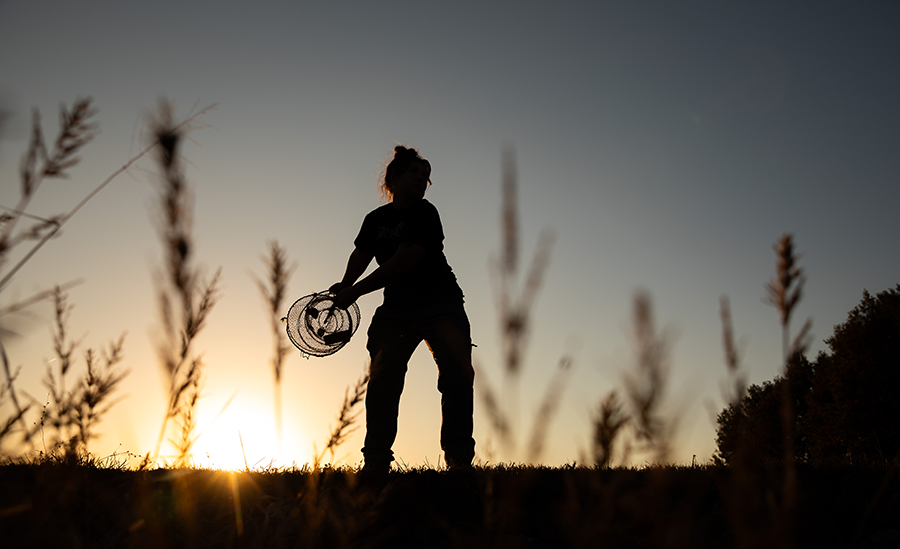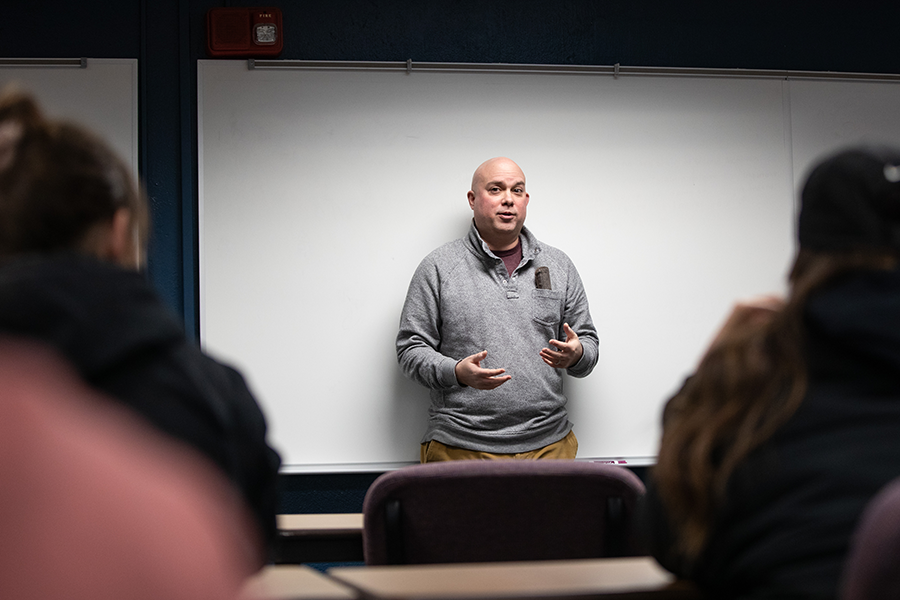Every other weekend, senior Saige Haddock wades knee-deep in the Asbury Field Site’s pond. Haddock unlatches the turtle traps (that are floating on pool noodles) to tag and track the animals who find themselves caught in their temporary confinement before returning them to their watery home.
“So far,” Haddock, a conservation major, began. “I have learned that the bigger the trap, the larger the catch, and to expect the unexpected.”
Located just feet away from the Kansas border lies the Asbury Field Site, two square miles of land and 200 acres of water privately owned by a local family. In 2020, an MSSU alumnus contacted Dr. David Penning, associate professor of Biology & Environmental Health and overseer of the Asbury Field Site project, on behalf of the family, arranging a partnership with the academic department.
“This project was built by pure luck,” said Penning. “We are fortunate to have this opportunity.”
The Asbury Field Site is a unique and rare location. The land contains around 150 acres of prairie remnant, the most endangered ecosystem in the world—less than .5% still exists on Earth. Protecting the land was vital for any research to take place.
Since ensuring the safety of the land, students of all levels and disciplines have traveled to the field biweekly, quantifying, describing, and measuring the reptiles and amphibians of the region. Some are responsible for the turtles, others for tracking and recording the reptiles found in the grass. Some students have created their own projects, leading their peers in research.
Haddock is the creator and leader of the Large Hoop Net Crew, a project where the group compares species richness and diversity found in traps with different mesh sizes. In this case, they are trapping larger species, such as spiny softshell turtles and common snapping turtles.
“Since nearly every net has captured a species of fish, I decided to add the information correlated with turtle data,” said Haddock. “The correlation is to test whether fish populations affect turtle population.”
Also overseeing their own projects are senior Luke Hatfield and recent graduate Gabe McClain, ‘24. McClain, who majored in ecology and conservation, ran the aquatics turtle survey. For two years, he tested the effects of bait type and flotation color on aquatic turtle capture rates. In other words, he tested if turtles responded differently to red, blue, or yellow flotations devices while also seeing if they show a preference for certain foods.
“Turtles are a heavy contributor to the aquatic environments, so learning their preferred diet allows scientists to draw conclusions on bigger concepts such as ecosystem level health,” said McClain. “What this means for future research is we can better perform aquatic turtle research if we use specific colors or baits to target different turtle species.”
The turtles aren’t the only animals found on the land. In addition to his work with McClain, Hatfield leads his own project. The conservation biology major is responsible for the coverboard project. Since the beginning of the research, the students have scattered 300 types of covering throughout the field’s grassland and woodland habitats. Constructed of materials ranging from plywood to metal in shapes like triangles, squares, and rectangles, these covers create custom habitats for these animals. Variables such as cover complexity (how many layers each coverboard contains) and the shape and type of each coverboard are used to study the effects of coverboard type, shape, and the detection of terrestrial reptiles and amphibians.
Every other Friday, Hatfield, McClain, and classmate Jerod Thomas four-wheel over to the transects. If the animal doesn’t evade the students, they take measurements of their length, weight, sex, and the type of coverboard where they are found before tagging them to track them in case of recapture.
The team is also beginning to collect data on the temperatures of the different layers on the coverboards.
“My favorite part of this project so far is simply being outside with other students who share my love for the outdoors and interacting with wildlife in a meaningful way,” said Hatfield, who returned to MSSU for a wildlife degree after a teaching career. “My career goal is to pursue some type of wildlife biology or conservation, so this project helps to give me experience with collecting data in the field and working with others.”
Among its discoveries, the Asbury Field Site is home to a rare species of salamander the students named the “slimy salamander.” The creature, scientifically known as the Plethodon albagula, is three inches long with white flakes sprinkled over its dark skin. The state of Kansas has only ever detected one individual found in Cherokee County in 1949, so it is assumed that it can be found there due to its proximity to the Missouri border.
“We found the amphibian on the Missouri side,” said Penning. “Salamanders don’t care about geopolitics, so if we found it that close to Kansas, the logic is that the ‘slimy salamander’ is likely found in the state today. Continued research hopes to verify this.”
The discoveries unearthed and research conducted on the Asbury Field Site have expanded beyond the property line. Students have presented their research at conferences, like MSSU’s Undergraduate Research Symposium and the Kansas Herpetological Society at Kansas University. Students like Hatfield have also written and are currently querying group research papers to esteemed scientific journals. The biggest impact the work has made on students is giving them a boost into graduate school and great job opportunities in places like the Missouri Department of Conservation.
And with science constantly evolving, there is no end in sight for the Asbury Field Site project.
“It will likely continue indefinitely,” said Penning. “Until I die or retire, whichever comes first.”




